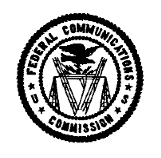FCC@80
According to the FCC’s first annual report in 1935, here are the key dates
- June 19, 1934 - Passage of the Communications Act
- July 11, 1934 - Swearing in of the first commissioners (7 in number until the 1980s)
- July 17, 1934 - First commission meeting
When FCC was created in 1934 the world was much simpler than today and the FCC had a somewhat different structure than today although it was not reflected in the statute. Like the Interstate Commerce Commission that was the predecessor to the FCC’s Title II jurisdiction, the initial 7 commissioner FCC divided itself into 3 “divisions” of 3 commissioners at creation in 1934 – dealing with: telephone, telegraph, and radio. The original intent was that the whole commission would meet en banc for issues affecting multiple industries or key decisions. Note that this was prior to the 1946 Administrative Procedures Act (APA) when the procedures for adopting and enforcing rules lacked today’s checks and balances, but were also much faster. Note also that prior to World War II the maximum frequency of practical use and the number of technological options for radio technology were very limited. While the 1934 FCC Annual Report mentioned in passing the “possibility” of VHF use “above 30 megacycles” or what would be called 30 MHz today, the highest frequency mentioned in actual routine use was 2.5 MHz.
At the same time of the arrival of the APA in 1946 came the postwar rapid explosion of available spectrum for practical use, many new technologies for using that spectrum, and an ever expanding categories of uses that have benefited both our economy and our society. But is the FCC, as presently structured able to deal with this workload efficiently? Experience shows that technical spectrum policy decisions are just not keeping up to the pace of today’s complex industry. While major players are able to demand timely action on some issues, e.g. DTV transition and incentive auctions, even these major players have to choose between which of their actions will get attention in a sort of informal rationing system. Entrepreneurial firms that are the hot bed of innovation in other technical areas just do not have access to much of the FCC’s limited decision-making throughput in the spectrum policy area and as a result get turnaround on technical policy issues that discourages investment in wireless technology requiring nonroutine FCC approvals. Even major incumbents are not getting a timely response of new unanticipated types of interference to their systems that need rulemaking action to resolve.
Your blogger has fundamental doubts whether today’s FCC as presently structured has the decision making throughput to do its basic spectrum management functions in timely way while faced with simultaneous issues such as incentive auction, net neutrality, and several megamergers. We believe that if the Commission will recognize this shortfall that it has the flexibility under Section 5(c) of the original Communications Act to increase its throughput by delegating more technocratic issues to the staff as its UK counterpart Ofcom does under the policy guidance of its “Board” which is analogous to the FCC commissioners. The Ofcom Board delegates most actions to its senior staff while maintaining policy control.
(We note that in Canada the politically sensitive issues of most interest to the 8th Floor are handled in the FCC-like Canadian Radio-television and Telecommunications Commission, while most technocratic issues are handled by the less politicized Spectrum, Information Technologies and Telecommunications sector of Industry Canada. While a Canada-like dichotomy would require legislation, much of the UK Ofcom functionality and improved productivity could be achieved under the terms of Section 5(c).)
We hope that FCC and the spectrum policy community will use this anniversary to contemplate whether the presently structured FCC is adequately keeping up to the task at hand in spectrum policy or whether the commissioners should use their Section 5 power to delegate more functions that they do not personally add value to.

Original FCC seal in 1934



![Validate my RSS feed [Valid RSS]](valid-rss-rogers.png)

